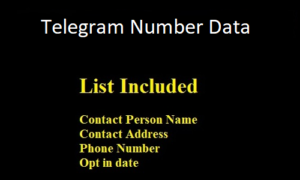A telegram is a form of communication that involves sending messages over long distances. This article explores the history and significance of telegrams as a means of conveying information quickly and efficiently Is a Message That Is Sent.
The Origin of Telegrams:
The concept of telegrams dates back to the 19th century when Samuel Morse developed the telegraph system in the United States. The telegraph allowed messages to be transmitted through a series of electrical signals, enabling communication across vast distances. Telegrams were initially sent in Morse code, a system of dots and dashes that Spain Telegram number Data represented letters and numbers.
The Rise of Telegram Services:
As the telegraph system expanded, telegram services became widespread and popular. Companies were established to facilitate the sending and receiving of telegrams, and telegram offices popped up in major cities around the world. Telegrams offered a rapid and reliable way to exchange important information, making them an essential tool for businesses, governments, and individuals.
The Telegram Format:
A typical telegram consists of a concise and straightforward message. The sender conveys their information within a limited number of words, often omitting unnecessary details. Telegrams were charged based on the number of words, so brevity was crucial to keep costs down.
The Importance of Telegrams in History:
During significant historical events, telegrams played a crucial role in spreading news and coordinating actions. For instance, during World War II, telegrams were vital for military communication and relaying important messages between leaders and troops. Similarly, telegrams were used to announce major events like the sinking of the Titanic and to deliver condolences and congratulations.
Telegram Decline and Modern Alternatives:
With the advent of more advanced communication technologies, the popularity of telegrams began to decline. The rise of the telephone, followed by the internet and email, provided faster and cheaper means of communication. Eventually, telegraph services were phased out in many countries.
The Legacy of Telegrams:
Although telegram services are no longer widely used, their influence on modern communication methods remains B2B Lead significant. The emphasis on brevity and clarity in telegram writing has carried over to text messaging and social media platforms. The concept of sending concise messages in real-time continues to shape the way we communicate today.
Conclusion:
In the annals of communication history, telegrams hold a unique and important place. From their inception in the 19th century to their widespread use during critical historical events, telegrams served as a lifeline for sharing information across great distances. While modern technologies have largely replaced telegram services, their legacy lives on in the form of concise messaging and rapid communication methods that define our present era.







